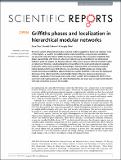| dc.contributor.author | Odor, Geza | |
| dc.contributor.author | Dickman, Ronald | |
| dc.contributor.author | Odor, Gergely | |
| dc.date.accessioned | 2015-12-28T17:53:41Z | |
| dc.date.available | 2015-12-28T17:53:41Z | |
| dc.date.issued | 2015-09 | |
| dc.date.submitted | 2015-04 | |
| dc.identifier.issn | 2045-2322 | |
| dc.identifier.uri | http://hdl.handle.net/1721.1/100539 | |
| dc.description.abstract | We study variants of hierarchical modular network models suggested by Kaiser and Hilgetag [ Front. in Neuroinform., 4 (2010) 8] to model functional brain connectivity, using extensive simulations and quenched mean-field theory (QMF), focusing on structures with a connection probability that decays exponentially with the level index. Such networks can be embedded in two-dimensional Euclidean space. We explore the dynamic behavior of the contact process (CP) and threshold models on networks of this kind, including hierarchical trees. While in the small-world networks originally proposed to model brain connectivity, the topological heterogeneities are not strong enough to induce deviations from mean-field behavior, we show that a Griffiths phase can emerge under reduced connection probabilities, approaching the percolation threshold. In this case the topological dimension of the networks is finite, and extended regions of bursty, power-law dynamics are observed. Localization in the steady state is also shown via QMF. We investigate the effects of link asymmetry and coupling disorder, and show that localization can occur even in small-world networks with high connectivity in case of link disorder. | en_US |
| dc.description.sponsorship | Hungarian Scientific Research Fund (OTKA Grant K109577) | en_US |
| dc.description.sponsorship | European Social Fund (Project FuturICT.hu Grant TAMOP-4.2.2.C-11/1/KONV-2012-0013) | en_US |
| dc.language.iso | en_US | |
| dc.publisher | Nature Publishing Group | en_US |
| dc.relation.isversionof | http://dx.doi.org/10.1038/srep14451 | en_US |
| dc.rights | Creative Commons Attribution | en_US |
| dc.rights.uri | http://creativecommons.org/licenses/by/4.0/ | en_US |
| dc.source | Nature Publishing Group | en_US |
| dc.title | Griffiths phases and localization in hierarchical modular networks | en_US |
| dc.type | Article | en_US |
| dc.identifier.citation | Odor, Geza, Ronald Dickman, and Gergely Odor. “Griffiths Phases and Localization in Hierarchical Modular Networks.” Scientific Reports 5 (September 24, 2015): 14451. | en_US |
| dc.contributor.department | Massachusetts Institute of Technology. Department of Mathematics | en_US |
| dc.contributor.mitauthor | Odor, Gergely | en_US |
| dc.relation.journal | Scientific Reports | en_US |
| dc.eprint.version | Final published version | en_US |
| dc.type.uri | http://purl.org/eprint/type/JournalArticle | en_US |
| eprint.status | http://purl.org/eprint/status/PeerReviewed | en_US |
| dspace.orderedauthors | Odor, Geza; Dickman, Ronald; Odor, Gergely | en_US |
| mit.license | PUBLISHER_CC | en_US |
| mit.metadata.status | Complete | |
